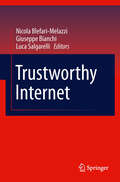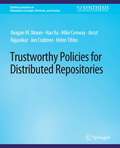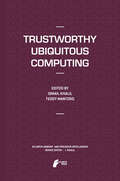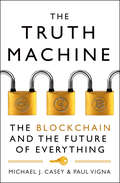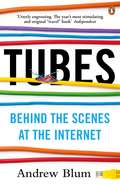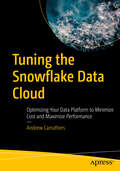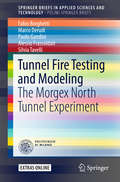- Table View
- List View
Trustworthy Global Computing: 9th International Symposium, TGC 2014, Rome, Italy, September 5-6, 2014. Revised Selected Papers (Lecture Notes in Computer Science #8902)
by Matteo Maffei Emilio TuostoThis book constitutes the thoroughly refereed post-conference proceedings of the 9th International Symposium on Trustworthy Global Computing, TGC 2014, held in Rome, Italy, in September 2014. The 15 revised full papers presented were carefully reviewed and selected from 20 submissions. The Symposium on Trustworthy Global Computing focuses on frameworks, tools, algorithms, and protocols for open-ended, large-scale systems and applications, and on rigorous reasoning about their behavior and properties.
Trustworthy Global Computing: 8th International Symposium, TGC 2013, Buenos Aires, Argentina, August 30-31, 2013, Revised Selected Papers (Lecture Notes in Computer Science #8358)
by Martín Abadi and Alberto Lluch LafuenteThis book constitutes the thoroughly refereed post-conference proceedings of the 8th International Symposium on Trustworthy Global Computing, TGC 2013, held in Buenos Aires, Argentina, in August 2013. The 15 revised full papers presented together with 3 invited talks were carefully reviewed and selected from 29 submissions. The papers cover a wide range of topics in the area of global computing and safe and reliable computation. They are organized in topical sections on security, π-calculus, information flow, models, specifications and proofs and quantitative analysis.
Trustworthy Global Computing: Second Symposium, TGC 2006, Lucca, Italy, November 7-9, 2006, Revised Selected Papers (Lecture Notes in Computer Science #4661)
by Ugo Montanari Donald Sannella Roberto BruniThis book constitutes the thoroughly refereed post-proceedings of the Second Symposium on Trustworthy Global Computing, TGC 2006, held in Lucca, Italy, in November 2006. The 14 revised papers presented together with two keynote lectures were carefully reviewed and selected from 32 submissions. The book starts off with activity reviews of four FP6 programmes of the European Union: Aeolus, Mobius, Sensoria, and Catnets.
Trustworthy Global Computing: International Symposium, TGC 2005, Edinburgh, UK, April 7-9, 2005. Revised Selected Papers (Lecture Notes in Computer Science #3705)
by Rocco De Nicola Davide SangiorgiTrustworthy Global Computing: 7th International Symposium, TGC 2012, Newcastle upon Tyne, UK, September 7-8, 2012, Revised Selected Papers (Lecture Notes in Computer Science #8191)
by Catuscia Palamidessi Mark D. RyanThis book constitutes the thoroughly refereed post-conference proceedings of the 7th International Symposium on Trustworthy Global Computing, TGC 2012, held in Newcastle upon Tyne, UK, in September 2012. The 9 revised full papers presented together with 3 invited talks were carefully reviewed and selected from 14 submissions. The papers cover a wide range of topics in the area of global computing and reliable computation in the so-called global computers, i.e., those computational abstractions emerging in large-scale infrastructures such as service-oriented architectures, autonomic systems and cloud computing, providing frameworks, tools, algorithms and protocols for designing open-ended, large-scale applications and for reasoning about their behavior and properties in a rigorous way.
Trustworthy Global Computing: 5th International Symposium, TGC 2010, Munich, Germany, February 24-26, 2010, Revised Selected Papers (Lecture Notes in Computer Science #6084)
by Martin Wirsing Martin Hofmann Axel RauschmayerGlobal computing refers to computation over “global computers,” i.e., com- tational infrastructures available globally and able to provide uniform services with variable guarantees for communication, cooperation and mobility, resource usage, security policies and mechanisms, etc., with particular regard to explo- ing their universal scale and the programmability of their services. As the scope and computational power of such global infrastructures continue to grow, it - comes more and more important to develop methods, theories and techniques for trustworthy systems running on global computers. This book constitutes the thoroughly refereed proceedings of the ?fth e- tion of the International Symposium on Trustworthy Global Computing (TGC 2010)thatwasheldinMunich,Germany,February24-26,2010.TheSymposium on Trustworthy Global Computing is an international annual venue dedicated to safe and reliable computation in global computers. It focuses on providing frameworks, tools, and protocols for constructing well-behaved applications and on reasoning rigorouslyabout their behavior and properties. The related models of computation incorporate code and data mobility over distributed networks with highly dynamic topologies and heterogeneous devices.
Trustworthy Hardware Design: Combinational Logic Locking Techniques (Analog Circuits and Signal Processing)
by Muhammad Yasin Jeyavijayan (JV) Rajendran Ozgur SinanogluWith the popularity of hardware security research, several edited monograms have been published, which aim at summarizing the research in a particular field. Typically, each book chapter is a recompilation of one or more research papers, and the focus is on summarizing the state-of-the-art research. Different from the edited monograms, the chapters in this book are not re-compilations of research papers. The book follows a pedagogical approach. Each chapter has been planned to emphasize the fundamental principles behind the logic locking algorithms and relate concepts to each other using a systematization of knowledge approach. Furthermore, the authors of this book are in a good position to be able to deliver such a book, as they contributed to this field significantly through numerous fundamental papers.
Trustworthy Internet
by Luca Salgarelli, Giuseppe Bianchi and Nicola Blefari-MelazziThis book collects a selection of the papers presented at the 21st International Tyrrhenian Workshop on Digital Communications, organized by CNIT and dedicated this year to the theme "Trustworthy Internet". The workshop provided a lively discussion on the challenges involved in reshaping the Internet into a trustworthy reality, articulated around the Internet by and for People, the Internet of Contents, the Internet of Services and the Internet of Things, supported by the Network Infrastructure foundation. The papers have been revised after the workshop to take account of feedbacks received by the audience. The book also includes: i) an introduction by the Editors, setting the scene and presenting evolution scenarios; ii) five papers written by the session chairmen, reputed scientists, and each dedicated to a facet of the trustworthy Internet vision; iii) a concluding paper, reporting the outcomes of a panel held at the conclusion of the workshop, written by the two keynote speakers.
Trustworthy Machine Learning for Healthcare: First International Workshop, TML4H 2023, Virtual Event, May 4, 2023, Proceedings (Lecture Notes in Computer Science #13932)
by Hao Chen Luyang LuoThis book constitutes the proceedings of First International Workshop, TML4H 2023, held virtually, in May 2023.The 16 full papers included in this volume were carefully reviewed and selected from 30 submissions. The goal of this workshop is to bring together experts from academia, clinic, and industry with an insightful vision of promoting trustworthy machine learning in healthcare in terms of scalability, accountability, and explainability.
Trustworthy Open Self-Organising Systems (Autonomic Systems #0)
by Wolfgang Reif Gerrit Anders Hella Seebach Jan-Philipp Steghöfer Elisabeth André Jörg Hähner Christian Müller-Schloer Theo UngererThis book treats the computational use of social concepts as the focal point for the realisation of a novel class of socio-technical systems, comprising smart grids, public display environments, and grid computing. These systems are composed of technical and human constituents that interact with each other in an open environment. Heterogeneity, large scale, and uncertainty in the behaviour of the constituents and the environment are the rule rather than the exception. Ensuring the trustworthiness of such systems allows their technical constituents to interact with each other in a reliable, secure, and predictable way while their human users are able to understand and control them. "Trustworthy Open Self-Organising Systems" contains a wealth of knowledge, from trustworthy self-organisation mechanisms, to trust models, methods to measure a user's trust in a system, a discussion of social concepts beyond trust, and insights into the impact open self-organising systems will have on society.
Trustworthy Policies for Distributed Repositories (Synthesis Lectures on Information Concepts, Retrieval, and Services)
by Reagan W. Moore Hao XU Mike Conway Arcot Rajasekar Jon CrabtreeA trustworthy repository provides assurance in the form of management documents, event logs, and audit trails that digital objects are being managed correctly. The assurance includes plans for the sustainability of the repository, the accession of digital records, the management of technology evolution, and the mitigation of the risk of data loss. A detailed assessment is provided by the ISO-16363:2012 standard, "Space data and information transfer systems—Audit and certification of trustworthy digital repositories." This book examines whether the ISO specification for trustworthiness can be enforced by computer actionable policies. An implementation of the policies is provided and the policies are sorted into categories for procedures to manage externally generated documents, specify repository parameters, specify preservation metadata attributes, specify audit mechanisms for all preservation actions, specify control of preservation operations, and control preservation properties as technology evolves. An application of the resulting procedures is made to enforce trustworthiness within National Science Foundation data management plans.
Trustworthy Reconfigurable Systems: Enhancing the Security Capabilities of Reconfigurable Hardware Architectures
by Thomas FellerThomas Feller sheds some light on trust anchor architectures for trustworthy reconfigurable systems. He is presenting novel concepts enhancing the security capabilities of reconfigurable hardware. Almost invisible to the user, many computer systems are embedded into everyday artifacts, such as cars, ATMs, and pacemakers. The significant growth of this market segment within the recent years enforced a rethinking with respect to the security properties and the trustworthiness of these systems. The trustworthiness of a system in general equates to the integrity of its system components. Hardware-based trust anchors provide measures to compare the system configuration to reference measurements. Reconfigurable architectures represent a special case in this regard, as in addition to the software implementation, the underlying hardware architecture may be exchanged, even during runtime.
Trustworthy Software Development Processes: International Conference on Software Process, ICSP 2009 Vancouver, Canada, May 16-17, 2009 Proceedings (Lecture Notes in Computer Science #5543)
by Qing Wang Vahid Garousi Raymond Madachy Dietmar PfahlThis volume contains papers presented at the International Conference on Software Process (ICSP 2009) held in Vancouver, Canada, during May 16-17, 2009. ICSP 2009 was the third conference of the ICSP series, continuing the software process workshops from 25 years ago. The theme of ICSP 2009 was “Processes to Develop Trustworthy Software.” Software development takes place in a dynamic context of frequently changing technologies and limited resources. Teams worldwide are under increasing pressure to deliver trustworthy software products more quickly and with higher levels of quality. At the same time, global competition is forcing software development organizations to cut costs by rationalizing processes, outsourcing part or all of their activities, re- ing existing software in new or modified applications and evolving existing systems to meet new needs, while still minimizing the risk of projects failing to deliver. To address these difficulties, new or modified processes are emerging including lean and agile methods, plan-based product line development, and increased integration with systems engineering processes. Papers present research and real-world experience in many areas of software and systems processes impacting trustworthy software including: new software devel- ment approaches; software quality; integrating software and business processes; CMMI and other process improvement initiatives; simulation and modeling of so- ware processes; techniques for software process representation and analysis; and process tools and metrics.
Trustworthy Systems Through Quantitative Software Engineering (Quantitative Software Engineering Series #1)
by Lawrence Bernstein C. M. YuhasA benchmark text on software development and quantitative software engineering "We all trust software. All too frequently, this trust is misplaced. Larry Bernstein has created and applied quantitative techniques to develop trustworthy software systems. He and C. M. Yuhas have organized this quantitative experience into a book of great value to make software trustworthy for all of us." -Barry Boehm Trustworthy Systems Through Quantitative Software Engineering proposes a novel, reliability-driven software engineering approach, and discusses human factors in software engineering and how these affect team dynamics. This practical approach gives software engineering students and professionals a solid foundation in problem analysis, allowing them to meet customers' changing needs by tailoring their projects to meet specific challenges, and complete projects on schedule and within budget. Specifically, it helps developers identify customer requirements, develop software designs, manage a software development team, and evaluate software products to customer specifications. Students learn "magic numbers of software engineering," rules of thumb that show how to simplify architecture, design, and implementation. Case histories and exercises clearly present successful software engineers' experiences and illustrate potential problems, results, and trade-offs. Also featuring an accompanying Web site with additional and related material, Trustworthy Systems Through Quantitative Software Engineering is a hands-on, project-oriented resource for upper-level software and computer science students, engineers, professional developers, managers, and professionals involved in software engineering projects. An Instructor's Manual presenting detailed solutions to all the problems in the book is available from the Wiley editorial department. An Instructor Support FTP site is also available.
Trustworthy Ubiquitous Computing (Atlantis Ambient and Pervasive Intelligence #6)
by Ismail Khalil Teddy MantoroTrustworthy Ubiquitous Computing covers aspects of trust in ubiquitous computing environments. The aspects of context, privacy, reliability, usability and user experience related to “emerged and exciting new computing paradigm of Ubiquitous Computing”, includes pervasive, grid, and peer-to-peer computing including sensor networks to provide secure computing and communication services at anytime and anywhere. Marc Weiser presented his vision of disappearing and ubiquitous computing more than 15 years ago. The big picture of the computer introduced into our environment was a big innovation and the starting point for various areas of research. In order to totally adopt the idea of ubiquitous computing several houses were build, equipped with technology and used as laboratory in order to find and test appliances that are useful and could be made available in our everyday life. Within the last years industry picked up the idea of integrating ubiquitous computing and already available products like remote controls for your house were developed and brought to the market. In spite of many applications and projects in the area of ubiquitous and pervasive computing the success is still far away. One of the main reasons is the lack of acceptance of and confidence in this technology. Although researchers and industry are working in all of these areas a forum to elaborate security, reliability and privacy issues, that resolve in trustworthy interfaces and computing environments for people interacting within these ubiquitous environments is important. The user experience factor of trust thus becomes a crucial issue for the success of a UbiComp application. The goal of this book is to provide a state the art of Trustworthy Ubiquitous Computing to address recent research results and to present and discuss the ideas, theories, technologies, systems, tools, applications and experiences on all theoretical and practical issues.
The Truth About HTML5
by RJ Owen Luke StevensThe Truth About HTML5 is for web designers, web developers, and front-end coders who want to get up to speed with HTML5. The book isn't afraid to point out what everyone gets wrong about HTML5's new markup, so you don’t make the same mistakes. It will show you what rocks in HTML5 today and what the future holds. Marking up a basic web page shouldn't be a quasi-religious exercise where the high priests of HTML5 must be consulted for their interpretation of the holy texts (the HTML5 spec). Don’t waste hours trawling through confusing, poorly researched, and often flat-out wrong information on the Internet. Get the truth on HTML5's markup here. You'll also find out about HTML5's new microdata standard that's being used on major websites, such as eBay and IMDB, right now, and get the low-down on the Canvas object and what it can and can't do for you. The book also covers how HTML5 affects CMSs and web apps, what HTML5 means for mobile, and what the future holds. HTML5 isn't one big blob of technology that will be "finished" at some point in the future. It’s a grab bag of cool stuff, much of which has been around for years. Learn what’s well supported and ready to go today. Now that the initial wave of hype is over, it's time to learn the truth about HTML5.
Truth and Fake in the Post-Factual Digital Age: Distinctions in the Humanities and IT Sciences
by Peter Klimczak Thomas ZoglauerThe increase in fake news, the growing influence on elections, increasing false reports and targeted disinformation campaigns are not least a consequence of advancing digitalisation. Information technology is needed to put a stop to these undesirable developments. With intelligent algorithms and refined data analysis, fakes must be detected more quickly in the future and their spread prevented. However, in order to meaningfully recognize and filter fakes by means of artificial intelligence, it must be possible to distinguish fakes from facts, facts from fictions, and fictions from fakes. This book therefore also asks questions about the distinctions of fake, factual and fictional. The underlying theories of truth are discussed, and practical-technical ways of differentiating truth from falsity are outlined. By considering the fictional as well as the assumption that information-technical further development can profit from humanities knowledge, the authors hope that content-related, technical and methodological challenges of the present and future can be overcome.
The Truth Machine: The Blockchain And The Future Of Everything
by Michael J. Casey Paul VignaFrom the authors of the fascinating The Age of Cryptocurrency, comes the definitive work on the Internet’s next big thing: the blockchain.
Truth, Proof and Infinity: A Theory of Constructive Reasoning (Synthese Library #276)
by P. FletcherConstructive mathematics is based on the thesis that the meaning of a mathematical formula is given, not by its truth-conditions, but in terms of what constructions count as a proof of it. However, the meaning of the terms `construction' and `proof' has never been adequately explained (although Kriesel, Goodman and Martin-Löf have attempted axiomatisations). This monograph develops precise (though not wholly formal) definitions of construction and proof, and describes the algorithmic substructure underlying intuitionistic logic. Interpretations of Heyting arithmetic and constructive analysis are given. The philosophical basis of constructivism is explored thoroughly in Part I. The author seeks to answer objections from platonists and to reconcile his position with the central insights of Hilbert's formalism and logic. Audience: Philosophers of mathematics and logicians, both academic and graduate students, particularly those interested in Brouwer and Hilbert; theoretical computer scientists interested in the foundations of functional programming languages and program correctness calculi.
Truth, Rationality, Cognition, and Music (Philosophical Studies Series #102)
by Jesus M. Larrazabal KepaKortaA speech for the defence in a Paris murder trial, a road-safety slogan, Hobbes' political theory; each appeals to reason of a kind, but it remains an oblique and rhetoricalldnd. Each relies on comparisons rather than on direct statements, and none can override or supersede the conclusions of ethical reasoning proper. Nevertheless, just as slogans may do more for road safety than the mere recital of accident statistics, or of the evidence given at coroners' inquests, so the arguments of a Hobbes or a Bentham may be of greater practical effect than the assertion of genuinely ethical or political statements, however true and relevant these may be. Stephen Toulmin, Reason in Ethics, 1950. The International Colloquium on Cognitive Science (ICCS), held in Donostia - San Sebastian every two years since 1989, has become one of the most important plazas for cognitive scientists in Europe to present the results of their research and to exchange ideas. The seventh edition, co-organized as usual by the Institute for Logic, Cognition, Language, and Information (ILCLI) and the Department of Logic and Philosophy of Science, both from the University of the Basque Country, took place from May 9 to 12, 200 1, addressing the following main topics: 1. Truth: Epistemology and Logic. 2. Rationality in a Social Setting. 3. Music, Language, and Cognition. Vlll TRUTH, RATIONALITY, COGNITION, AND MUSIC 4. The Order of Discourse: Logic, Pragmatics, and Rhetoric.
The TSQL2 Temporal Query Language (The Springer International Series in Engineering and Computer Science #330)
by Richard T. SnodgrassTemporal databases have been an active research topic for at least fifteen years. During this time, several dozen temporal query languages have been proposed. Many within the temporal database research community perceived that the time had come to consolidate approaches to temporal data models and calculus based query languages, to achieve a consensus query language and associated data model upon which future research can be based. While there were many query language proposals, with a diversity of language and modeling constructs, common themes kept resurfacing. However, the community was quite frag mented, with each research project being based on a particular and different set of assumptions and approaches. Often these assumptions were not germane to the research per se, but were made simply because the research required a data model or query language with certain characteristics, with the partic ular one chosen rather arbitrarily. It would be better in such circumstances for research projects to choose the same language. Unfortunately, no existing language had attracted a following large enough to become the one of choice. In April, 1992 Richard Snodgrass circulated a white paper that proposed that a temporal extension to SQL be produced by the research community. Shortly thereafter, the temporal database community organized the "ARPA/NSF In ternational Workshop on an Infrastructure for Temporal Databases," which was held in Arlington, TX, in June, 1993.
Tubes: Behind the Scenes at the Internet
by Andrew BlumThe Internet. Home to the most important and intimate aspects of our lives. Our careers, our relationships, our selves, all of them are out there - online. So ... where is that exactly? And who's in charge again? And what if it breaks?In Tubes Andrew Blum takes us on a gripping backstage tour of the real but hidden world of the Internet, introducing us to the remarkable clan of insiders and eccentrics who own, design and run it everyday. He uncovers the secret data warehouses where our online selves are stored, peels back the wires that transport us across the globe, reveals its mammoth hubs and surprising alley-ways, explaining what the Internet actually is, where it is, how it got there - and, yes, what happens when it breaks.
Tuning Metaheuristics: A Machine Learning Perspective (Studies in Computational Intelligence #197)
by Mauro BirattariTuning the Snowflake Data Cloud: Optimizing Your Data Platform to Minimize Cost and Maximize Performance
by Andrew CarruthersThis project-oriented book presents a hands-on approach to identifying migration and performance issues with experience drawn from real-world examples. As you work through the book, you will develop skills, knowledge, and deep understanding of Snowflake tuning options and capabilities while preparing for later incorporation of additional Snowflake features as they become available. Your Snowflake platform will cost less to run and will improve your customer experience. Written by a seasoned Snowflake practitioner, this book is full of practical, hands-on guidance and advice specifically designed to further accelerate your Snowflake journey. Tuning the Snowflake Data Cloud provides you a pathway to success by equipping you with the skills, knowledge, and expertise needed to elevate your Snowflake experience. The book shows you how to leverage what you already know, adds what you don’t, and helps you apply it toward delivering for your Snowflake accounts. Read this book to embark on a voyage of advancement and equip your organization to deliver consistent Snowflake performance. What You Will Learn Recognize and understand the root cause of performance bottlenecks Know how to resolve performance issues Develop a deep understanding of Snowflake performance tuning options Reduce expensive mistakes, remediate poorly performing code Manage Snowflake costs
Tunnel Fire Testing and Modeling: The Morgex North Tunnel Experiment (SpringerBriefs in Applied Sciences and Technology)
by Fabio Borghetti Marco Derudi Paolo Gandini Alessio Frassoldati Silvia TavelliThis book aims to cast light on all aspects of tunnel fires, based on experimental activities and theoretical and computational fluid dynamics (CFD) analyses. In particular, the authors describe a transient full-scale fire test (~15 MW), explaining how they designed and performed the experimental activity inside the Morgex North tunnel in Italy. The entire organization of the experiment is described, from preliminary evaluations to the solutions found for management of operational difficulties and safety issues. This fire test allowed the collection of different measurements (temperature, air velocity, smoke composition, pollutant species) useful for validating and improving CFD codes and for testing the real behavior of the tunnel and its safety systems during a diesel oil fire with a significant heat release rate. Finally, the fire dynamics are compared with empirical correlations, CFD simulations, and literature measurements obtained in other similar tunnel fire tests. This book will be of interest to all engineers and public officials who are concerned with the nature, prevention, and management of tunnel fires.







